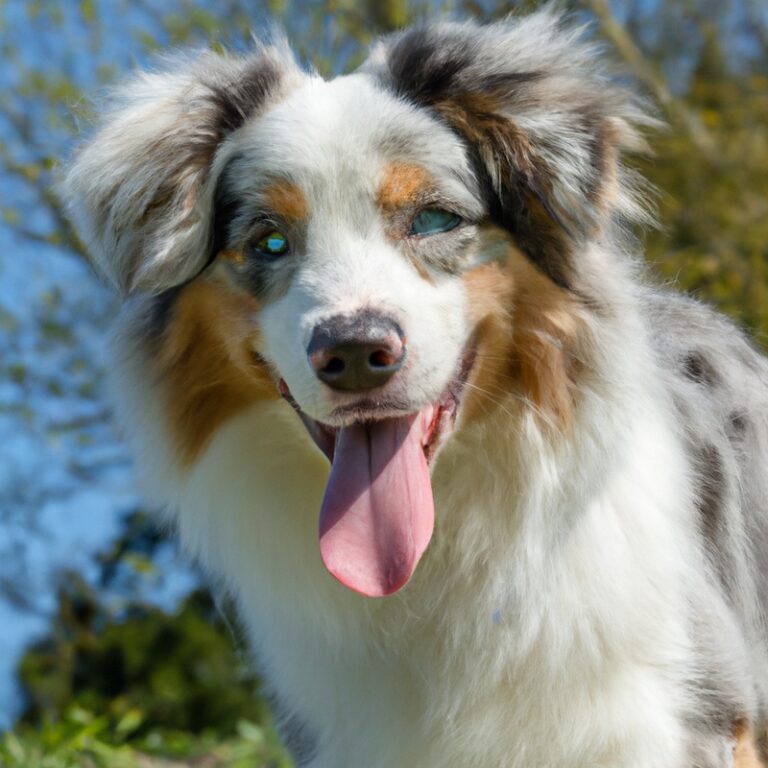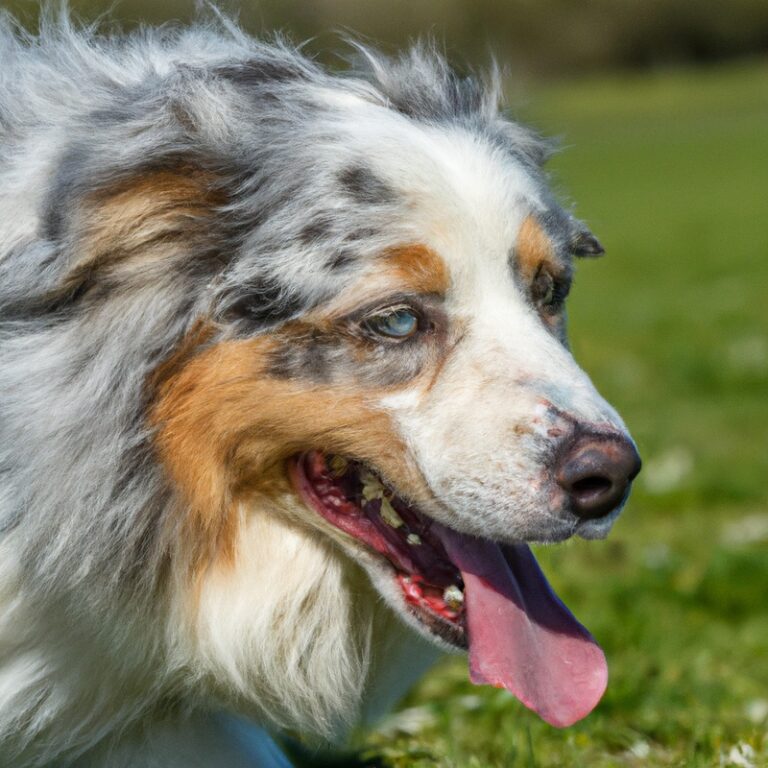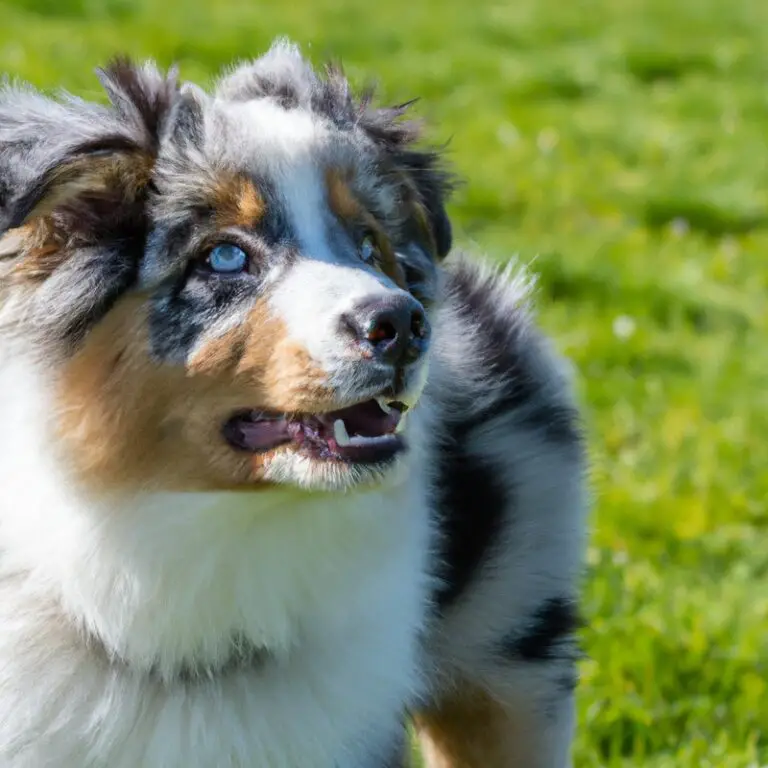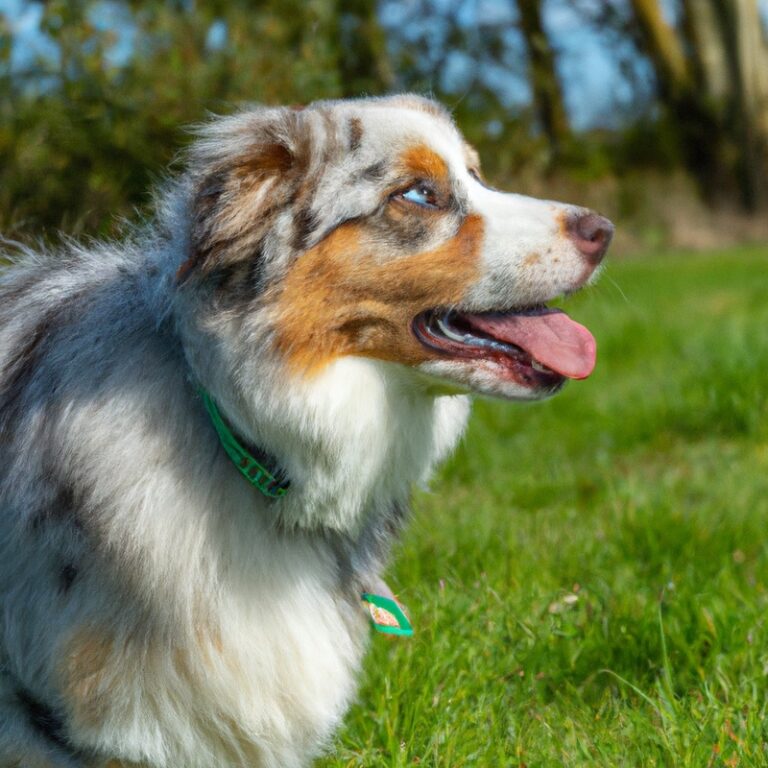How Do Australian Shepherds Behave When Introduced To New Farm Animals Like Goats Or Pigs?
Key Takeaways:
- Australian Shepherds show a strong herding instinct when introduced to new farm animals.
- They are generally adaptable and quick learners, able to adjust their behavior accordingly.
- Australian Shepherds may display some initial excitement, but can be trained to behave calmly and respectfully around farm animals.
- Proper socialization and training play key roles in ensuring positive interactions between Australian Shepherds and new farm animals.
Are you a proud owner of an Australian Shepherd, or perhaps considering bringing one into your life? If so, you may be wondering how these intelligent and energetic dogs behave when introduced to new farm animals like goats or pigs.
As an expert in canine behavior and a lover of these remarkable herding dogs, I am excited to delve into the fascinating world of Australian Shepherds and their interactions with farm animals.
Join me as I explore the factors that influence their behavior, offer tips for successful introductions, and address potential challenges along the way. So, let’s grab our virtual leashes and embark on this enlightening journey together!
| Behavior | Reaction |
| Australian Shepherd | Introduction to new farm animals |
| Curiosity | Approaches with caution |
| Sniffs and observes | |
| Herding Instinct | May attempt to herd |
| May nip or chase | |
| Adaptability | Can adapt to new animals with proper training |
| May take time to adjust | |
| Friendliness | May be friendly towards animals if socialized |
| Natural Predatory Instinct | May show prey drive towards smaller animals |
| Need proper supervision |
Factors Influencing Australian Shepherd’s Behavior
Genetic Predisposition and Herding Instincts
Australian Shepherds have a genetic predisposition for herding instincts. This means that they have an innate ability and desire to control and move livestock.
These instincts are deeply ingrained in their DNA, as they were originally bred to work on farms and ranches.
As a result, Australian Shepherds may display behaviors such as circling, nipping, or barking at animals they perceive as needing to be herded. It’s important to understand and manage these instincts when introducing Australian Shepherds to new farm animals like goats or pigs.
Early Socialization and Training
Early socialization and training are crucial for Australian Shepherds when it comes to their behavior around new farm animals like goats or pigs. During the early stages of their life, it’s important to expose Australian Shepherds to a variety of different animals, including goats and pigs, in a controlled and positive manner.
This helps them develop positive associations and reduces the likelihood of fear or aggression later on.
Training should focus on basic commands, such as “sit,” “stay,” and “leave it,” which can be applied when interacting with farm animals. Positive reinforcement, such as treats and praise, should be used to reward desired behavior.
Consistency and patience are key when training Australian Shepherds to behave appropriately around farm animals.
Overall, early socialization and training play a significant role in shaping an Australian Shepherd’s behavior when introduced to new farm animals. By providing them with positive experiences and consistent training, they are more likely to adapt well and have positive interactions with goats, pigs, and other farm animals.
Previous Experiences with Farm Animals
Previous experiences with farm animals can greatly influence how an Australian Shepherd behaves when introduced to new ones like goats or pigs. If an Australian Shepherd has had positive encounters with farm animals in the past, they are more likely to exhibit calm and friendly behavior towards them.
On the other hand, if they have had negative experiences, it may result in fear, anxiety, or aggression towards farm animals.
It is important to consider an Australian Shepherd’s previous experiences and any potential trauma they may have gone through. These experiences can shape their behavior and reactions in future encounters.
If your Australian Shepherd has had limited exposure to farm animals, it is crucial to introduce them gradually and ensure positive experiences.
Remember, each Australian Shepherd is unique, and their behavior can vary based on their individual personalities and past experiences. By understanding and addressing their previous encounters, you can help create a positive and successful introduction to new farm animals.
Introducing Australian Shepherds to Goats
Separation and Controlled Introduction
When introducing Australian Shepherds to new farm animals like goats or pigs, separation and controlled introduction are key. It’s important to start by separating the Australian Shepherd and the farm animal, allowing them to get familiar with each other’s scent and presence.
Once both parties are comfortable, controlled introductions can begin.
This involves gradually exposing the Australian Shepherd to the farm animal in a supervised setting, ensuring both safety and positive experiences. Positive reinforcement and rewards can be utilized to reinforce good behavior and create positive associations.
Positive Reinforcement and Rewards
Positive reinforcement and rewards play a significant role when introducing Australian Shepherds to new farm animals like goats or pigs. Rather than using punishment or force, I find it more effective to focus on positive reinforcement techniques.
These techniques involve rewarding the desired behavior with treats, praise, or play.
By using positive reinforcement, I can communicate to my Australian Shepherd that their interactions with the goats or pigs are positive and rewarding experiences. For example, when my dog approaches the animals calmly and without aggression, I make sure to reward them with treats and praise.
This reinforces the behavior and encourages them to continue behaving in a friendly and respectful manner.
Consistency is key when using positive reinforcement. I make sure to reward my Australian Shepherd every time they exhibit the desired behavior, whether it’s approaching the animals gently or remaining calm in their presence.
This helps reinforce the connection between the behavior and the reward.
It’s important to keep in mind that every dog is unique, and what works for one dog may not work for another. Some dogs may be more motivated by food rewards, while others may respond better to play or verbal praise.
It’s important to find what motivates your Australian Shepherd and use that as a reward during the introduction process.

Gradual Exposure and Supervision
Gradual exposure and supervision are key when introducing Australian Shepherds to new farm animals like goats or pigs. It’s important to start with controlled interactions in a safe and controlled environment.
Begin by allowing the Australian Shepherd to observe the goats or pigs from a distance while on a leash.
Gradually decrease the distance over time as they become more comfortable. Always supervise the interactions closely to ensure the safety of both the dog and the farm animal.
Watch for signs of fear, aggression, or overexcitement, and intervene if necessary.
Positive reinforcement is vital during the process. Reward the Australian Shepherd for calm and appropriate behavior around the farm animals, using treats, praise, or toys.
Remember, each dog is unique, and the introduction process may vary.
Take it slow, be patient, and consult with a professional trainer or behavioral expert if needed. With gradual exposure and proper supervision, your Australian Shepherd can learn to coexist peacefully with goats or pigs on the farm.
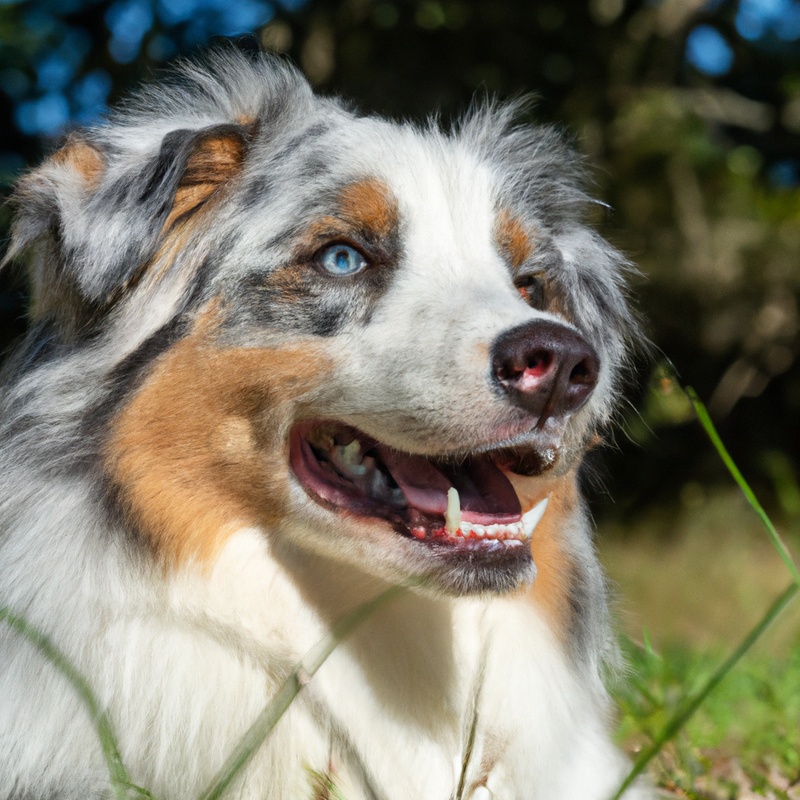
Introducing Australian Shepherds to Pigs
Understanding Pig Behavior
Understanding pig behavior is crucial when introducing Australian Shepherds to them. Pigs are naturally social animals, and they communicate through vocalizations, body language, and scent.
They establish a hierarchy within their group and can be territorial.
Pigs also have a strong prey drive, which can trigger excitement in dogs like Australian Shepherds. It’s important to introduce them slowly and calmly, allowing them to become familiar with each other’s scents and gradually increasing their interaction under supervision.
Managing the dog’s prey drive and excitement is essential to ensure a successful introduction.
Slow and Calm Introduction
When introducing Australian Shepherds to new farm animals like goats or pigs, it’s important to take a slow and calm approach. Rushing the introduction can lead to stress and potential conflicts.
Start by allowing your Australian Shepherd to observe the animals from a distance, either on a leash or in a controlled area.
This will help them get used to the sight, sound, and smell of the animals without feeling overwhelmed. Gradually decrease the distance between your dog and the animals over time, always closely monitoring their behavior.
Keep the interactions short and positive, rewarding your dog for calm and relaxed behavior.
If your Australian Shepherd shows signs of excitement or prey drive, redirect their attention with a command or a toy. This will help them associate the presence of the animals with positive experiences.
Remember to remain patient and consistent throughout the introduction process.
Each dog is different, so the time it takes for them to feel comfortable around new farm animals may vary. Seek guidance from a professional trainer or behavioral expert if needed.
Managing Prey Drive and Excitement
Managing Prey Drive and Excitement When it comes to introducing Australian Shepherds to new farm animals like goats or pigs, managing their prey drive and excitement is crucial. Here are some tips to help with this:
- Use positive reinforcement: Reward your Australian Shepherd for calm and controlled behavior around the animals. This can help them associate the animals with positive outcomes and reduce their prey drive.
- Gradual exposure and supervision: Start with controlled and supervised interactions in a safe environment. Gradually increase the exposure and monitor your dog’s behavior closely. This allows them to get used to the presence of the animals without becoming overly excited.
- Teach command cues: Train your Australian Shepherd to respond to specific command cues, such as “leave it” or “stay.” This can help redirect their attention and manage their prey drive when they become overly excited.
- Mental and physical stimulation: Ensure that your Australian Shepherd receives sufficient mental and physical exercise before introducing them to farm animals. A tired dog is more likely to be calmer and less prone to excessive excitement or prey drive.
- Consistency and patience: Be consistent in your training methods and patient with your dog’s progress. Remember that each dog is unique, and it may take time for them to adjust to new animals. Stay calm and positive during the process to instill confidence in your dog.
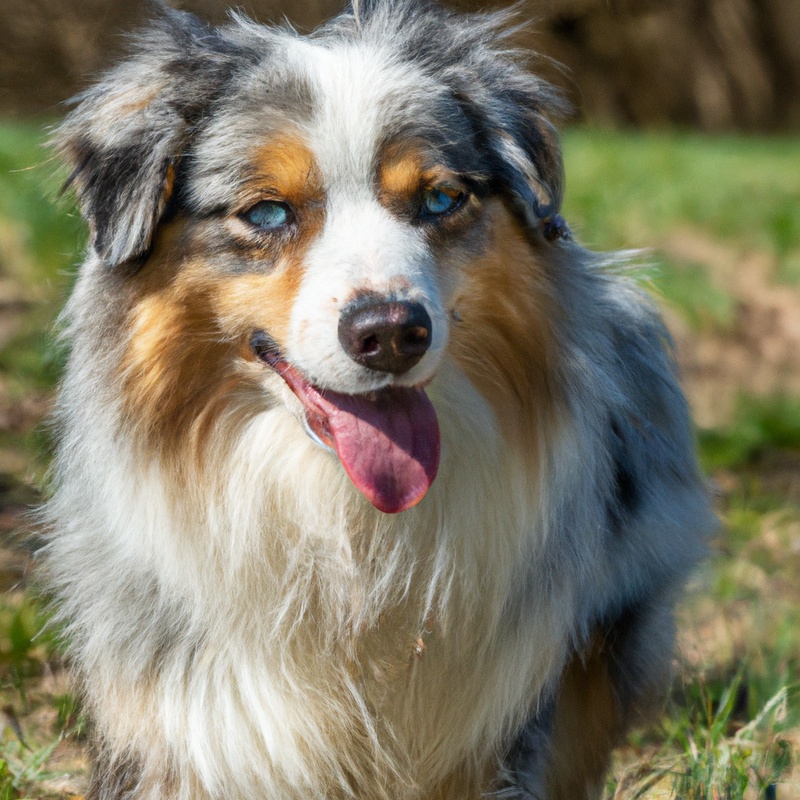
Tips for Successful Introductions
Familiarizing the Australian Shepherd with Scent and Sounds
To familiarize your Australian Shepherd with the scent and sounds of new farm animals like goats or pigs, start by letting them sniff items that carry the scent of the animals, such as bedding or fur. This helps them become accustomed to the new smells before direct interactions.
You can also play recordings of the sounds made by goats or pigs to expose your Australian Shepherd to these sounds in a controlled environment.
Gradually increase the volume and duration of the recordings to help them become more comfortable. It’s important to approach this process with patience and positive reinforcement.
Reward your Australian Shepherd with treats or praise when they display calm behavior in the presence of the scents or sounds.
Remember to take it slow and not overwhelm your dog with too much too soon. Gradual exposure and consistency are key.
By familiarizing your Australian Shepherd with the scent and sounds of the new farm animals, you can help reduce anxiety and increase their confidence when introduced to them directly.
Proper Leash and Containment Measures
When introducing Australian Shepherds to new farm animals like goats or pigs, it is important to use proper leash and containment measures. This will ensure the safety of both the dog and the animals.
Using a secure leash and harness will give you control over your Australian Shepherd’s movements and prevent any unwanted chasing or aggression.
Make sure the leash is strong and in good condition to prevent any breakage. If possible, it is best to introduce the Australian Shepherd to the farm animals in a contained area.
This can be a fenced-off section of the farm or a small enclosed pen.
This will allow for a controlled and supervised interaction between the dog and the animals. Always keep a close eye on your dog’s body language when introducing them to the farm animals.
Look for signs of excitement or aggression, such as raised hackles or stiff body posture.
If you notice any signs of tension, it is important to intervene and separate the dog from the animals to prevent any potential harm. Consistency is key when using leash and containment measures.
Make sure to use them every time you introduce your Australian Shepherd to new farm animals, even if you think the dog is already familiar with them.
This will reinforce the boundaries and expectations for your dog’s behavior around the animals. Positive reinforcement can also be helpful when using leash and containment measures.
Reward your Australian Shepherd with treats and praise when they exhibit calm and appropriate behavior around the farm animals.
This will further reinforce positive associations and encourage good behavior in the future. By using proper leash and containment measures, you can ensure a safe and successful introduction between Australian Shepherds and farm animals like goats or pigs.
Consistency, Patience, and Positive Reinforcement
Consistency, patience, and positive reinforcement are key when introducing Australian Shepherds to new farm animals like goats or pigs. It’s important to be consistent in your approach and expectations, as this will help your dog understand what is wanted from them.
Patience is also crucial, as it may take time for the dog to adjust to the new animals and for positive behaviors to develop.
Additionally, positive reinforcement, such as treats or praise, helps to reinforce good behavior and encourages the dog to continue behaving well around the farm animals. With consistency, patience, and positive reinforcement, you can help your Australian Shepherd successfully adapt to and interact with new farm animals.
Potential Challenges and Solutions
Herding Instincts and Overexcitement
Australian Shepherds have a natural herding instinct, which means they may exhibit certain behaviors when introduced to new farm animals like goats or pigs. Their herding instinct can cause them to chase, nip, or attempt to control the movement of these animals.
Additionally, Australian Shepherds can sometimes become overexcited in the presence of farm animals.
They may become overly energetic, bark excessively, or exhibit high levels of arousal. It’s important to understand these tendencies in order to manage the introduction process effectively.
Fear or Aggression Towards Farm Animals
Fear or aggression towards farm animals is a common issue that Australian Shepherds may display when introduced to them. This behavior can be a result of a lack of exposure or negative experiences with farm animals.
Some Australian Shepherds may be fearful of the size or movements of the animals, while others may display aggression due to their herding instincts.
It is important to address this behavior early on and provide proper socialization and training to help your Australian Shepherd feel comfortable and confident around farm animals. Gradual exposure and positive reinforcement can be effective in reducing fear and aggression.
It is crucial to supervise the interactions between your Australian Shepherd and farm animals to ensure everyone’s safety.
Consulting with a professional trainer or behavioral expert can also be beneficial in addressing these behavioral issues.
Working with Professional Trainers or Behavioral Experts
Working with professional trainers or behavioral experts can be extremely helpful when introducing Australian Shepherds to new farm animals like goats or pigs. These experts have the knowledge and experience to properly assess your dog’s behavior and provide effective training techniques.
Professional trainers can create customized training plans based on your specific needs and goals.
They can guide you on how to gradually expose your Australian Shepherd to the new animals, using positive reinforcement and rewards. They will also teach you how to manage your dog’s prey drive and excitement, ensuring a safe and controlled introduction.
Behavioral experts can help address any fear or aggression your Australian Shepherd may exhibit towards farm animals.
They can use techniques such as desensitization and counter-conditioning to help your dog overcome these negative behaviors. They can also provide valuable insights into understanding your dog’s breed-specific instincts and how to work with them.
Working with professionals allows you to have a knowledgeable and objective perspective on your dog’s behavior.
They can offer constructive feedback and guidance throughout the process, helping you and your Australian Shepherd achieve a successful and harmonious relationship with farm animals.
Final Verdict
Introducing Australian Shepherds to new farm animals like goats or pigs requires a combination of genetic understanding, early socialization, and positive reinforcement training. Controlled introductions, gradual exposure, and proper management of prey drive are essential for a successful integration.
Familiarizing the dog with scent and sounds, implementing proper leash and containment measures, and consistently using positive reinforcement techniques are key tips for successful introductions.
However, potential challenges may arise, such as overexcitement or fear/aggression towards farm animals. In these cases, seeking assistance from professional trainers or behavioral experts can greatly help in overcoming these challenges.
Overall, with the right approach and guidance, Australian Shepherds can adapt well to interacting with new farm animals, enhancing both their own well-being and the farming experience.


